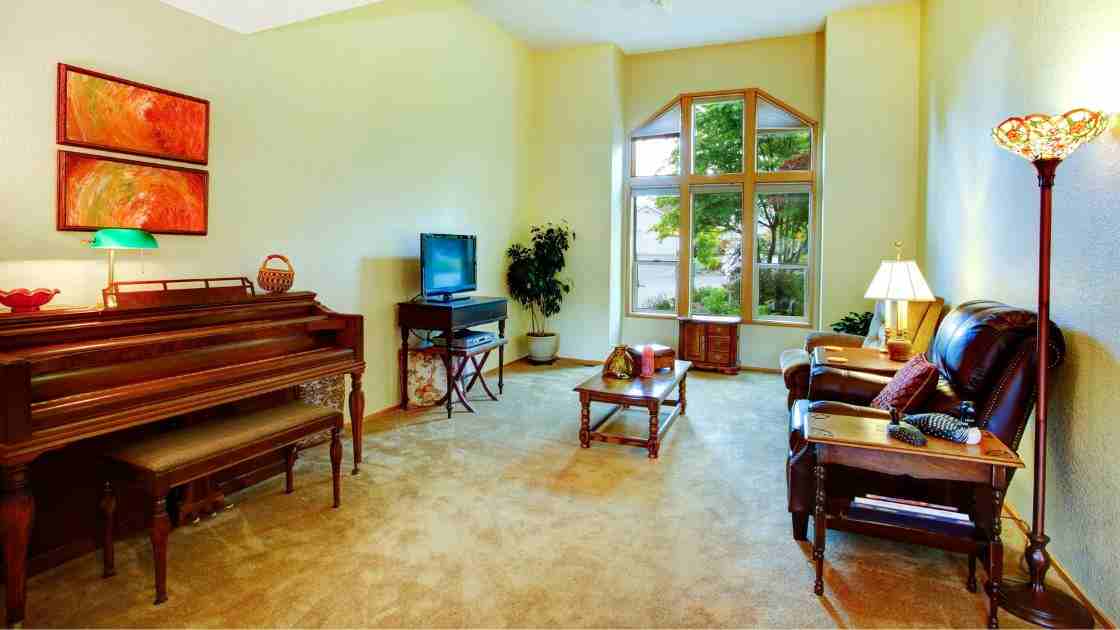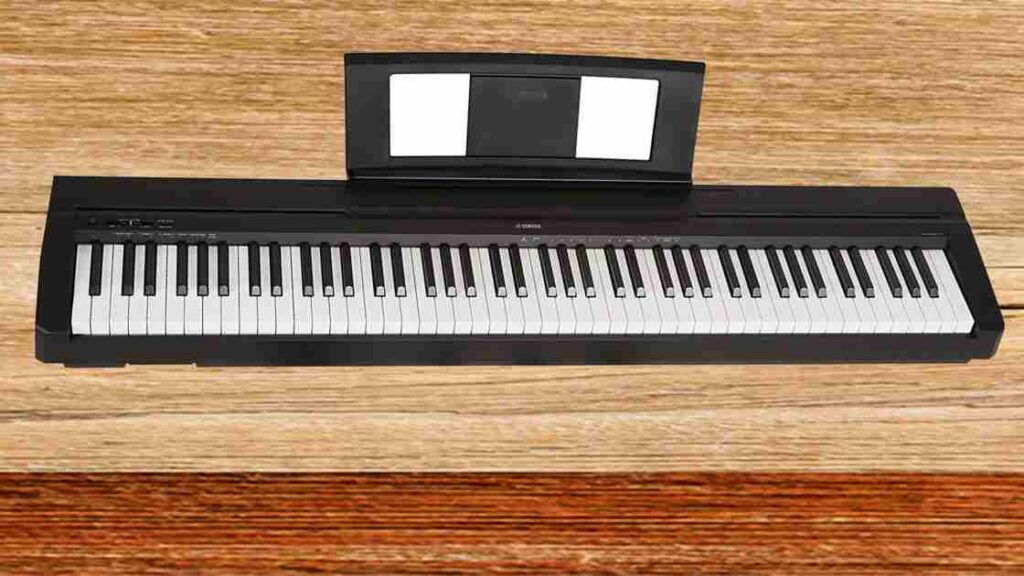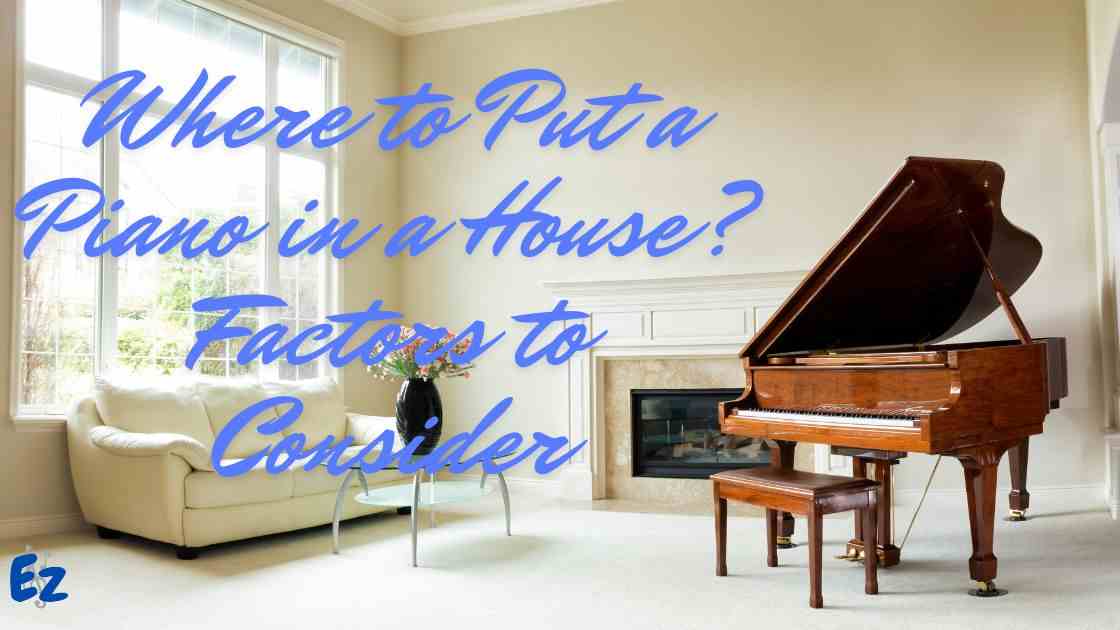Placing a piano in the right location within your home is crucial for both the instrument’s longevity and the quality of its sound. Where should a piano be placed in a house?
Here are some key considerations to help you choose the best spot for your piano.
Table of Contents
Environmental Considerations
The environment in which a piano is placed significantly affects its condition, longevity, and performance. Understanding and managing these environmental factors is crucial for maintaining the instrument’s quality.
Temperature and Humidity
Pianos are sensitive to temperature fluctuations. Drastic changes can cause the wooden components to expand and contract, leading to potential damage.
In addition, humidity levels directly affect the wooden parts and the felt components of a piano. Both high and low humidity levels can cause significant issues.
Place the piano in a room with a stable climate, ideally between 68-72°F (20-22°C) and relative humidity of around 42-55%.
Many piano manufacturers, such as Steinway, comment on the ambient condition of pianos.
Maintain a Stable Climate in a Piano Room
Maintaining a stable climate in the room where your piano is placed is crucial for the piano’s lifespan and performance.
Here are some practical tips to ensure the environment remains consistent.
Temperature Control
Use a reliable thermostat to monitor and maintain the desired temperature, ideally between 68-72°F (20-22°C). Programmable thermostats can be particularly useful for automatically adjusting the temperature to stay within the ideal range.
To prevent uneven heating, position the piano away from direct heat sources such as radiators, heating vents, fireplaces, and stoves.
Humidity Control
Use a humidifier in dry climates or during winter when indoor air is dry. Conversely, use a dehumidifier in humid climates or during summer months to reduce excess moisture. Maintain a relative humidity level between 42-55%.
Consider Installing a hygrometer in the piano room to monitor humidity levels. Choose a digital hygrometer for precise readings.
Airflow Management
- Avoid Drafts: Place the piano away from windows and exterior doors, and direct airflow from air conditioning units and fans. Drafts can cause rapid temperature and humidity changes.
- Even Airflow: Ensure the room has a consistent and gentle airflow to prevent pockets of stagnant air. This can be achieved by using ceiling fans on a low setting or installing an air circulation system.
- Moisture Protection: Do not place the piano in a damp area, like a basement, to prevent rust and wood warping.
Sunlight Protection
For whatever reason, if you need to put the piano near windows, there are still some ways to protect your piano.
- Curtains and Blinds: Use curtains, blinds, or shades to protect the piano from direct sunlight. UV rays can damage the piano’s finish and affect the wood.
- Window Films: Apply UV-protective films to windows to reduce the impact of sunlight without completely blocking natural light.
Room Acoustics

Considering the acoustic impact when placing a piano ensures that the instrument’s sound is at its best, providing an optimal auditory experience and supporting the player’s performance.
Place the piano in a room with good acoustics. Rooms with hard surfaces (like wood or tile floors) can reflect sound better, but too many hard surfaces can make the sound overly bright and harsh.
Carpets, drapes, and upholstered furniture can help balance the acoustics by absorbing excess sound.
Practical Considerations
Several things, such as space, room traffic, and aesthetics, are worthy of consideration for easy access and playing comfort.
These considerations help maintain the piano’s condition, enhance sound quality, and provide a better playing experience.
Space and Accessibility
Ensure there is enough space around the piano for the lid to be opened fully (for grand pianos) and for proper airflow. Avoid cramming the piano into a tight corner.
You also want to have easy access to the piano. Place the piano in a location that is easily accessible for regular playing and maintenance, ensuring there is enough room for the pianist and the bench.
Visibility and Aesthetics
A piano can be a beautiful centerpiece. Place it in a living room, music room, or other prominent area where it can be appreciated visually and acoustically.
Choose a location where you or your family will enjoy playing and listening to the piano most often.
Protect from Damage
Placing the piano in high-traffic areas where it might be bumped or scratched. Keeping it in a quieter, less busy part of the house can help preserve its condition.
Consider placing the piano in a location that minimizes the risk of damage from pets or young children.
Where Should a Piano Be Placed in a House?
As discussed above, choosing the best room for a piano in your house involves balancing environmental stability, acoustics, and practicality.
The best room for a piano in a house is typically a living room or a dedicated music room. These spaces offer the best balance of accessibility, acoustic potential, and environmental control.
Living rooms provide a central, social setting, while dedicated music rooms offer a focused environment with optimal acoustic treatment.
Ensure the chosen room has enough space, controlled temperature and humidity, and minimal exposure to direct sunlight and drafts to keep the piano in excellent condition.
Where to Put an Upright Piano in a House?

Placing an upright piano in your home requires specific considerations to ensure optimal performance.
Wall Placement
It is best to place an upright piano against an interior wall rather than an exterior wall. Interior walls are more stable in terms of temperature and humidity, protecting the piano from external elements.
Leave a small gap (about 2 to 4 inches) between the piano and the wall to allow for proper air circulation.
Sound Reflection
Placing the back of the piano against a solid wall can help reflect sound into the room, enhancing the instrument’s volume and richness.
Ensure the wall is not covered with heavy drapes or thick materials that might dampen the sound excessively.
Position the piano to face the room rather than into a corner or towards a window. This helps distribute the sound more evenly throughout the space.
Grand Piano Placement in a Home

When placing a grand piano in your home, thoughtful planning is essential to maximize its performance, maintain its sound quality, and preserve its structural integrity.
Specific considerations should be taken into account.
Space and Room Size
Grand pianos range from 5 feet (baby grands) to over 9 feet (concert grands). It is important to ensure the room can comfortably accommodate the piano, allowing enough space for the pianist and listeners.
Leave sufficient clearance around the piano for easy access, playing, and maintenance. Ideally, have at least 3 feet of space on all sides, especially on the side with the keyboard.
Larger grand pianos require larger rooms to allow their sound to resonate fully. A small room may cause the piano to sound overly loud and confined, while a large room allows the sound to develop naturally.
Acoustic Considerations
- Lid Up: For the best sound projection, place the piano so that the lid can be opened fully. This allows the sound to project into the room effectively. Typically, the curved side of the piano should face the audience or the main listening area.
- Lid Down: If space or volume control is a concern, you can also play with the lid down or use the lid prop to adjust the lid to a lower position.
- Sound Reflection: Rooms with a mix of hard and soft surfaces provide balanced acoustics. Hardwood or tile floors with area rugs, along with a combination of curtains, furniture, and acoustic panels, can help manage sound reflections.
- Wall Proximity: Grand pianos should have their open lid facing into the room to allow sound to carry more effectively.
- Avoid Echoes: Too many hard surfaces can cause excessive brightness and echo. Use soft furnishings to absorb some sound and create a balanced acoustic environment.
By considering these specific factors, you can ensure your grand piano is in an optimal location that enhances its sound quality, maintains its condition, and adds aesthetic value to your home.
Where to Place a Digital Piano?

Placing a digital piano in your home involves different considerations compared to an acoustic piano. Digital pianos are generally more adaptive to environmental conditions and less affected by temperature and humidity fluctuations.
Unlike acoustic pianos, which have wooden components that can expand or contract in response to changes in humidity, digital pianos consist primarily of electronic components, less susceptible to environmental changes.
Here are some specific considerations when placing a digital piano in a home.
Power Supply and Connectivity
- Power Source: Ensure the digital piano is placed near a power outlet to avoid long and potentially hazardous power cords. Using a surge protector is recommended to protect the piano from power surges.
- Connectivity: If you plan to connect your digital piano to other devices (computers, speakers, amplifiers, etc.), ensure it is near the necessary outlets and ports.
Moisture and Dust
Keep the piano away from areas prone to moisture and dust, such as kitchens and bathrooms.
Dust can accumulate in the keys and electronic components, potentially causing malfunctions. Liquid spills will also damage the electronic of the digital piano resulting in operational issues.
Mobility
Digital pianos are generally lighter and more portable than acoustic pianos. If you need to pack it and go, consider placing it in a location that allows for easy movement.
Playing Comfort
Many portable digital pianos do not come with a stand. You can place the digital piano on any tabletop or desktop. However, positioning the piano at an appropriate height is critical for comfortable playing.
Adjustable stands or furniture designed for pianos can help achieve the correct height.
Summary of Where to Put a Piano in a House
An optimal location for your upright piano enhances its lifespan, maintains its sound quality, and makes it a beautiful addition to your home.
Proper planning and placement of a grand piano will enhance this magnificent instrument’s musical and aesthetic value.
While digital pianos are more adaptive to environmental conditions, it’s still important to take basic precautions to protect them from excessive moisture, direct sunlight, and extreme temperatures, as these can still affect electronic components and overall performance over time.
Where to put a piano in a house is critical. Selecting the right location for your piano involves balancing environmental stability, acoustic quality, and practical considerations. By placing your piano in a stable, acoustically favorable, and accessible spot, you can ensure it remains in excellent condition and provides beautiful sound for years.
Related Articles:

